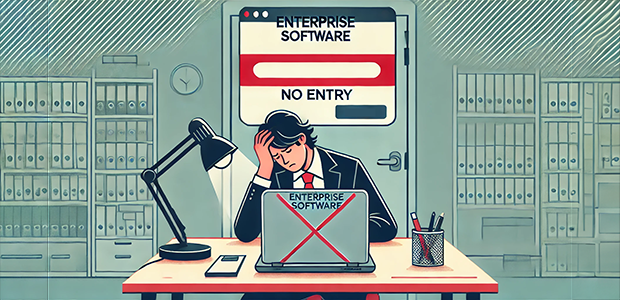
Is your enterprise software holding you back?
In 2023, global spending on enterprise software exceeded $900 billion, according to Statista. In many cases, enterprise tech offers a quick, affordable solution to everyday business needs, but sometimes you’ll find yourself tied into frustrating, inefficient software.
When you start to feel like your enterprise tech might be holding you back, how should you address it? It comes down to whether you have a unique, complex need that is core to your business, says Craig Cook, principal engineer at legacy software upgrade specialist Catapult.
Enterprise technology is a broad church, encompassing tools for customer relationship management (CRM), enterprise resource planning (ERP), HR management, product information management, and more. Generally, software solves a problem that’s not unique to your business, such as filling in timesheets, a commercial-off-the-shelf (COTS) product is usually sufficient. Some COTS offer (limited) customisation, so they can be tweaked to your business case, and there are many brilliant tools out there.
Parity or progress
The phrase “buy for parity, build for competitive advantage,” sums up the core argument in the buy vs build debate. Being tied into a constrained third-party platform can make it difficult to innovate, stay competitive, and offer good user experience – you’re using the same software as your competitors, after all.
If enterprise technology isn’t well maintained, it can rapidly become a legacy system that’s no longer supported or up to date, creating siloes, carrying a cost and introducing a security risk. If you’re in a specialised industry, such as finance, banking, or insurance, you might find the engineers able to maintain the technology are expensive.
Many businesses leave it there – while the cracks are showing, the enterprise tech isn’t broken, so why fix it? Change is huge, and legacy system migration is a long, expensive process. Businesses instead might try to customise their off-the-shelf product to fit a process or service, which can be expensive. It also makes the product harder to maintain and update – essentially negating the benefits to using COTS in the first place.
Building custom software
For businesses tied into enterprise software that feel like they are losing their competitive advantage, custom software could deliver value – particularly if the application is closely linked to the business’ core competencies. In a recent RackSpace survey, 72% of respondents prioritised building customised applications for customer facing purposes to create differentiation.
Working with a reputable consultancy on your custom software product can help get a minimum viable product (MVP) in the hands of users quickly, so you can take an incremental approach to improving it over time based on user feedback. Importantly, your software partner should offer support throughout the initiative as an ongoing partner – it’s definitely not one and done.
We’ve seen many cases where businesses have spent months, and millions, working with a consulting company on bespoke software. While the business is usually happy with the initial product, they find later down the line that it can’t be maintained, enhanced or scaled, and becomes legacy quickly. When investing in custom software, you must run it as a product and not a project to avoid this happening.
We find an agile, incremental approach delivers better results than waterfall. Changes can quickly be made in response to customer feedback, strategic business decisions, or changing market conditions and value can be generated more quickly.

